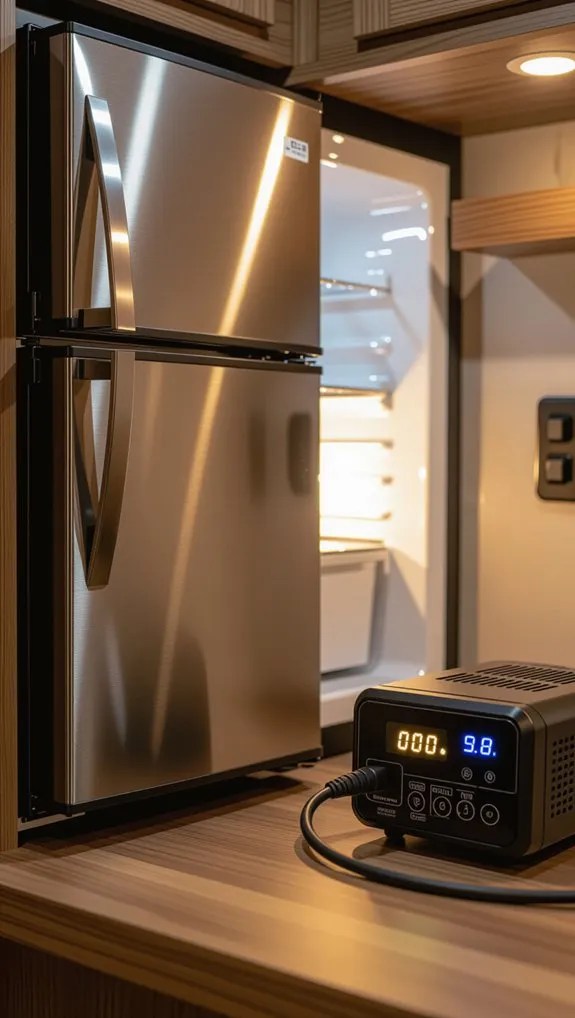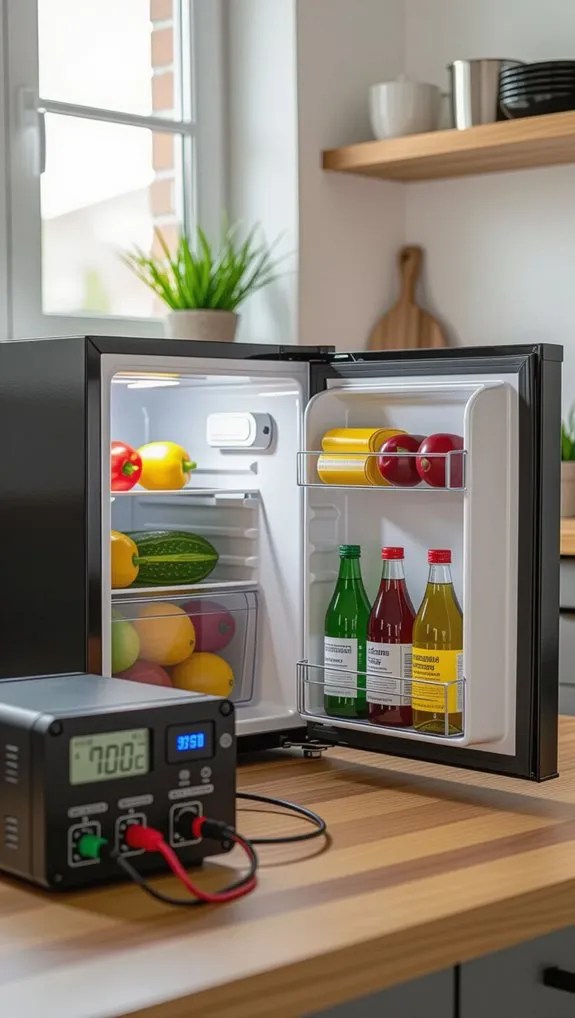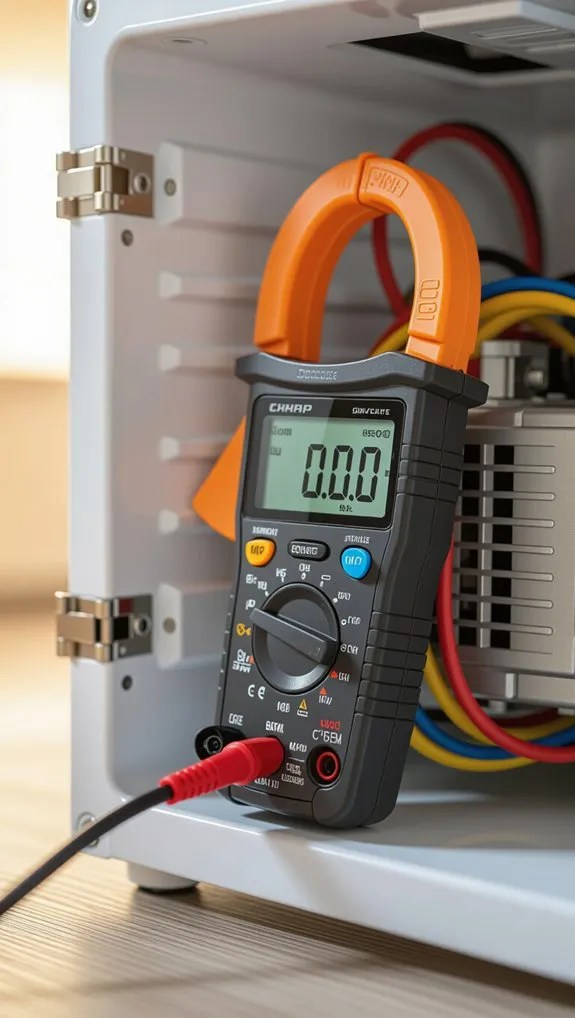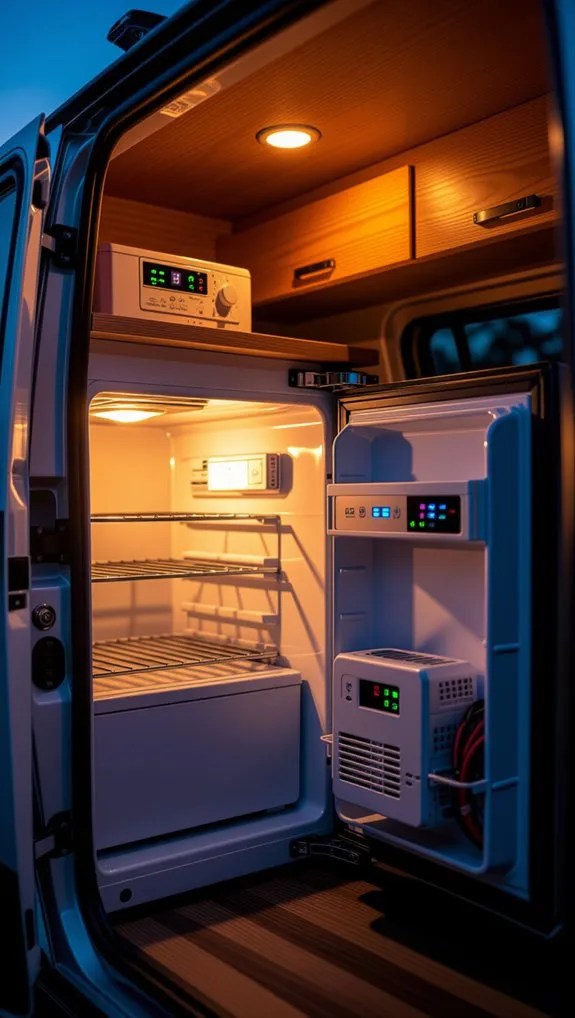Ever found yourself staring at your 1000W inverter and wondering, “Can a 1000W inverter run a fridge?” You’re not alone. This is one of the most common questions among RV enthusiasts, off-grid homeowners, and anyone looking to power their refrigerator with alternative energy sources. The answer isn’t a simple yes or no – it depends on several crucial factors that can make or break your cooling setup.
Understanding whether your inverter can handle your fridge involves more than just comparing wattage numbers. Your refrigerator’s startup surge, continuous power draw, and your inverter’s efficiency all play vital roles in this power equation. Get it wrong, and you could face anything from frequent shutdowns to a completely fried inverter.
In this post, we’ll break down exactly what you need to know to make this setup work reliably. We’ll cover how to calculate your fridge’s real power needs, what type of inverter works best, and the practical steps to ensure your food stays cold without any unpleasant surprises.
Can a 1000W inverter run fridge?

Let’s tackle whether a 1000W inverter can power your RV refrigerator with confidence.
A typical 1000W pure sine wave inverter usually handles most household fridges smoothly.
Most refrigerators run between 100–300W continuously, which falls well within the inverter’s capacity.
The key challenge is the fridge startup power, which can spike 2–3 times the running wattage.
Fortunately, many 1000W inverters have surge capabilities of 1500–2200W, making them compatible with most RV refrigerators.
Just be sure to verify your specific fridge’s startup and running watts to ensure reliable, cool performance on the road.
What size inverter do fridges need
Choosing the right inverter size for your RV refrigerator isn’t just about picking a random wattage—it’s about ensuring your food stays perfectly chilled mile after mile.
Your refrigerator needs two key power measurements: start-up power and continuous power. Most home fridges require 100-300 watts running, but they’ll spike 2-3 times higher during startup. A 1000W inverter with 1500-2200W surge capacity typically handles small-to-medium refrigerators. Always check your specific fridge’s nameplate for exact wattage requirements.
Insider tip: Factor in inverter efficiency (85-90%) and allow a safety margin to prevent unexpected power interruptions during your travels.
How many watts RV fridges draw

Powering an RV refrigerator isn’t a one-size-fits-all scenario, and comprehension of wattage draw is crucial for reliable cooling on the road. RV fridges vary widely in power consumption, from compact models drawing 50-75W to larger units pulling 300-500W during running power.
| Fridge Size | Typical Watts | Compressor Startup | Inverter Surge |
|---|---|---|---|
| Small (7-10 cu ft) | 50-75W | 300-900W | Moderate |
| Medium | 100-300W | 600-1200W | High |
| Large | 300-500W | 1000-2000W | Very High |
| Commercial | 500+W | 2000+W | Extreme |
Understanding compressor startup and inverter surge helps prevent unexpected power interruptions during your travels.
Start surge versus running watts basics
When diving into RV refrigerator power dynamics, grasping the difference between start surge and running watts can make or break your cooling strategy. Starting power is the brief, intense burst of electricity needed to kick-start your fridge’s compressor, typically 2-3 times higher than running power. Running power, the steady electricity required to keep things cool, typically ranges from 50-300 watts.
That peak surge moment is critical—if your inverter can’t handle those initial watts, your fridge won’t start, leaving you with warm food and melted ice. Comprehending these power nuances ensures reliable cooling on the road.
Battery bank sizing and runtime estimates

More than a few RV owners underestimate the critical role battery bank sizing plays in keeping their fridge running smoothly during off-grid adventures.
When calculating runtime, I always recommend dividing your battery’s usable watt-hours by the fridge’s average power consumption. Don’t forget to account for inverter efficiency and duty cycle – a 150W compressor might only average 45-75W continuous. Inverter idle draw can further reduce available runtime, so size your battery bank with a 1.5-2× margin. This approach ensures you’ll run your battery reliably and keep your food cold, even during extended trips.
Solar charging and alternator assist tips
After calculating your battery bank’s capacity, the next step is ensuring you’ve got reliable power sources to keep those batteries topped up. An MPPT charge controller maximizes solar charging efficiency, while alternator assist provides a backup power solution.
| Power Source | Efficiency | Charging Speed |
|---|---|---|
| Solar Panels | 95% | Moderate |
| Alternator | 80-90% | Fast |
| DC-to-DC Charger | 95% | Optimized |
My pro suggestion? Configure a smart DC-to-DC charger to leverage your vehicle’s alternator without overloading it. This ensures your inverter-powered fridge stays cool, even during long drives, by maintaining consistent battery charge and preventing unexpected power interruptions.
How to measure your fridge load

Measuring your fridge’s electrical load isn’t rocket science, but you’ll want the right tools to get accurate results.
A plug-in meter like a Kill-A-Watt can give you basic readings, while a clamp meter with inrush capabilities provides more precise startup and running power measurements.
Your refrigerator’s data plate can also offer valuable baseline information about its electrical requirements, helping you determine if your 1000W inverter can handle the cooling challenge.
Plug-in meter
A power detective’s toolkit is essential for grasping your RV refrigerator’s energy appetite. A plug-in power meter lets you measure running power accurately, revealing exactly how many watts your fridge consumes during steady operation.
While these meters are helpful, they often miss the critical inrush/peak surge when the compressor first starts. That’s why I recommend complementing your plug-in meter with a clamp meter featuring an inrush function to capture those startup spikes.
Helpful hint: Take multiple readings across different temperatures to get a comprehensive grasp of your fridge’s true energy demands.
Clamp meter
Building on the insights from the plug-in meter, a clamp meter becomes your go-to tool for grasping your RV fridge’s true power consumption. This device lets you capture both running power and inrush current with precision.
By placing the clamp around one AC conductor, you’ll measure the steady current (typically 1-3 A) and those critical startup spikes when the compressor kicks in. Multiply current by voltage to calculate watts, and you’ll know exactly how much power your fridge demands.
Repeated measurements at different temperatures ensure you’ll size your inverter perfectly, keeping your food cold and your system running smoothly.
Data plate
The data plate is your refrigerator’s roadmap to power consumption, hidden like a treasure map on the back or inside the door of your RV fridge. Comprehending its cryptic codes helps you match inverter capabilities to your cooling needs.
| Data Plate Reading | Inverter Compatibility |
|---|---|
| Volts/Amps | Running Watts |
| 120V, 2.0A | ~240W |
| Surge Amps | Peak Inverter Capacity |
When checking running and starting watts, remember that inverters must handle both steady-state and initial surge currents. Your fridge’s data plate reveals critical power requirements, ensuring you’ll keep your food cold without overloading your electrical system.
How to wire the inverter safely

When wiring your inverter for your RV fridge, you’ll want to focus on three critical safety aspects: proper fusing to protect against electrical shorts, using short DC cables to minimize voltage drop, and ensuring a solid chassis ground connection.
I recommend installing a 150 A fuse as close to the battery positive terminal as possible, using appropriately sized 2/0–4 AWG cables with the shortest practical run to maintain efficient power transfer.
Grounding the inverter correctly to your vehicle’s chassis is the final crucial step to create a safe, reliable power setup that’ll keep your fridge running smoothly on the road.
Proper fusing
Safeguard your RV’s electrical system by mastering proper inverter fusing—a critical step that prevents potential fires, protects expensive equipment, and ensures reliable power for your refrigerator.
When running a 1000W inverter to power your fridge, select a high-quality ANL fuse rated for 150A or per manufacturer specifications. Place the fuse within 7-12 inches of the battery, using 1/0 AWG cable to minimize voltage drop. This approach handles high peak power demands while protecting your valuable cooling equipment from electrical risks, ensuring your fridge runs smoothly and safely throughout your adventures.
Short cables
Dial in your inverter wiring to keep your RV fridge running smoothly and prevent electrical headaches down the road.
When setting up a 1000 W inverter, keeping cables short is crucial to minimize voltage drop. I recommend keeping DC cable length under 18 inches from the battery positive terminal, which helps reduce peak-current losses during fridge compressor startup.
Shorter cables mean less resistance and better electrical performance.
Route cables carefully, avoiding sharp edges and heat sources, and secure them with clamps every 12–18 inches for a safe, reliable connection that keeps your food cold.
Chassis ground
Grounding your RV inverter correctly isn’t just a technical detail—it’s the foundation of electrical safety when running your fridge on the road. Chassis ground ensures your inverter operates reliably and protects against electrical hazards.
| Component | Connection | Purpose |
|---|---|---|
| Inverter Negative | Battery Negative | Common Return Path |
| AC Earth | Vehicle Chassis | Safety Grounding |
| Ground Lead | Short, Thick Cable | Prevent Stray Voltages |
| Bonding Point | Low-Resistance Connection | Electrical Protection |
Bond the inverter AC earth/ground directly to your vehicle’s chassis using a short, low-resistance conductor. Keep grounding/bonding conductors direct and secure, ensuring your fridge stays cool and your electrical system stays safe.
Troubleshooting warm fridge on inverter power

Troubleshooting a warm fridge while running on inverter power requires a systematic approach to pinpoint potential cooling disruptions. Start by verifying you’re using a pure sine wave inverter, which ensures the instantaneous power required by your compressor is delivered efficiently.
Check for voltage sag that can disrupt cooling performance, making sure your battery doesn’t drop below the inverter’s low-voltage threshold. Measure the fridge’s actual power draw with a clamp meter, confirming the inverter’s surge capacity matches the compressor’s startup needs.
Investigate potential overheating or installation issues that might compromise your refrigerator’s cooling ability.
Best inverter features for RV fridges
When hunting for the perfect inverter to keep your RV fridge running smoothly, you’ll want to zero in on several key features that can make or break your cooling performance. A pure sine wave inverter with robust surge/peak power rating of 1500-2200W ensures your compressor starts reliably without tripping.
Look for models with low no-load draw (ideally ≤10W) to prevent unnecessary battery drain during cycling. Prioritize inverters with solid overload protection, thermal safeguards, and high efficiency (85-95%) to guarantee consistent cooling. Choose a unit compatible with your battery bank and featuring remote switching for seamless power management.
Frequently Asked Questions
How Many Batteries Do I Need for a 1000 Watt Inverter?
I recommend two 12V 100Ah batteries in parallel for a 1000W inverter, ensuring reliable power, preventing battery stress, and providing enough capacity for continuous loads without frequent deep discharge.
What Appliances Will a 1000 Watt Inverter Run?
I’ll power most mini-fridges, energy-efficient refrigerators up to 10 cu ft, smaller kitchen appliances like blenders, microwaves, and laptops. But you’ll want to check specific wattage requirements and surge capacity before plugging in larger devices.
How Long Will a 1000 Watt Battery Run a Refrigerator?
I’ll run a typical 150W fridge for about 7-8 hours on a single 100 Ah battery, or up to 14-16 hours when accounting for the compressor’s on/off cycling under moderate conditions.
Is It Safe to Run a Refrigerator on an Inverter?
Yes, it’s safe to run a refrigerator on an inverter if you use a pure sine wave model, check startup surge requirements, ensure proper cooling, and match your inverter’s capacity to the fridge’s power needs.
In Conclusion
So, can a 1000W inverter run a fridge? The answer is yes, but success depends on choosing the right refrigerator and understanding your power limitations. While a 1000W inverter can handle most RV fridges during normal operation, you’ll need to account for startup surges and ensure your battery bank can sustain the load. The key is matching your inverter capacity to your specific fridge’s requirements and having adequate power storage.
Running your RV fridge on a 1000W inverter isn’t just possible—it’s practical with the right setup. Always verify your specific model’s wattage requirements, use heavy-duty cables, and choose an inverter with robust surge protection. By grasping your fridge’s power needs and investing in quality equipment, you’ll keep your food cool and your adventures worry-free.
Smart planning means reliable cooling, no matter where the road takes you. If you’re shopping for a new RV refrigerator that works efficiently with your 1000W inverter setup, check out our comprehensive RV refrigerator reviews to explore smart, well-reviewed options that balance performance with power efficiency.

